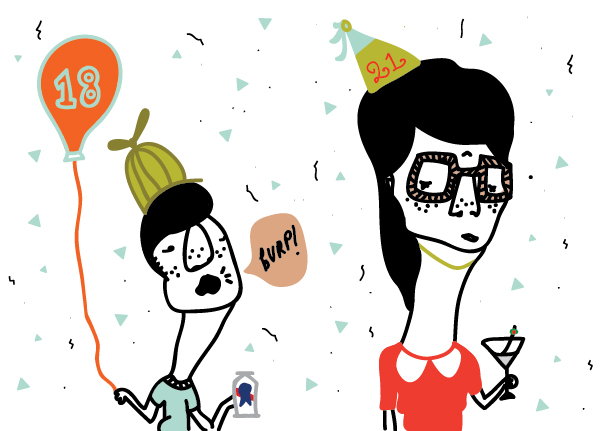Drinking age still cause for debate

Drinking age still cause for debate
March 10, 2014
For nearly a century, the U.S. has heavily regulated alcohol for fear of excessive consumption, sparking controversy about what the appropriate drinking age is.
While some want to lower the legal age, which is currently 21, a Feb. 24 article in the Journal of Studies on Alcohol and Drugs, titled “Case Closed: Research Evidence on the Positive Public Health Impact of the Age 21 Minimum Legal Drinking Age in the United States,” concluded that the current age restriction saves lives. Studies have shown lower rates of alcohol-related traffic accidents and decreased alcohol consumption among young people when the legal drinking age is 21.
The nation’s legal-drinking age has wavered throughout history. For nearly 40 years, most states voluntarily set their minimum drinking age to 21. But in the early ‘70s, 29 states lowered the drinking age to 18 to match the minimum age to enlist in the military and vote.
However, the nation saw an immediate increase in drunk-driving crashes and alcohol-related accidents, which ultimately resulted in the National Minimum Drinking Age Act of 1984, a measure prohibiting those younger than 21 from purchasing or publicly possessing alcohol.
“The evidence is clear that there would be consequences if we lowered the legal drinking age,” said William DeJong, lead author of the review and professor in the Department of Community Health and Sciences at the Boston University School of Public Health.
It is estimated that the drinking age of 21 saves 900 lives from alcohol-related traffic fatalities among underage drivers annually, according to the National Highway Transportation Safety Administration.
In 2002, 46 studies examined the impact of shifting the minimum drinking age in various states and found that a higher legal drinking age led to fewer traffic accidents, according to the review. The Centers for Disease Control and Prevention also concluded that fatal and nonfatal injury crashes increased by 10 percent when the drinking age was lowered, but they decreased by 16 percent when the age was raised.
The review does not include new research but is a meta-analysis of studies conducted throughout the past decade, according to Barrett Seaman, president of the board of directors at Choose Responsibility, which seek to reform drinking age laws. Seaman said the review’s cumulative research is perhaps asking the wrong question of whether or not the drinking age of 21 has reduced drunk driving.
“The right question to ask should be, ‘Is outlawing alcohol consumption by an entire cohort of American citizens the most effective way of reducing drunk driving and otherwise promoting a healthy approach to alcohol consumption?’” Seaman said. “In most of the rest of the world, the answer would be no. What works is tougher enforcement of drunk-driving laws for all ages of drivers.”
Seaman said the current drinking age has contributed to the “binge-drinking” culture among underage college students because they are forced to drink secretively.
“[Raising the drinking age] has not stopped drinking among college students, it simply drove it underground,” Seaman said. “In my estimation, [the law] made it worse and more dangerous than it had been when people were drinking out in the open and legally. The problem is we’ve built up a culture that celebrates excessive drinking to the point where people no longer seem to suffer from the consequences.”
However, Toben Nelson, associate professor at the University of Minnesota’s School of Public Health, said Choose Responsibility’s argument is invalid and research done thus far largely proves the opposite.
“The evidence is very clear that when the drinking age is lower, young adults and teens drink more, and when it’s higher they drink less and experience fewer problems as a result,” Nelson said.
Seaman said Choose Responsibility is not only advocating to lower the drinking age but also wants to implement an educational program similar to a driver’s education course in which someone turning 18 would enroll in a 10-week course that would concentrate on all aspects of alcohol, and completion of the program would grant students a drinker’s license.
“Like any license, it’s a privilege and can be revoked at any time,” Seaman said. “We believe that if you have this kind of license, it would go a long way in helping to change a culture that has been deteriorating for the past 30 years since this law went into effect.”
While DeJong recognizes the realities of underage drinking, the review rejects claims that underage binge-drinking has increased because the drinking age is 21.
The review cited findings conducted by the University of Michigan’s Monitoring the Future study, which found that heavy drinking rates among college students have decreased from 43.2 percent in 1988, when all 50 states required drinkers to be at least 21, to 36.1 percent in 2011. The study also revealed that rates among high school seniors decreased from 34.7 percent in 1988 to 21.6 percent in 2011.
DeJong said while Choose Responsibility believes lowering the drinking age will make people more responsible, historically it has not proven to be beneficial.
“Well in the early ‘70s, we did lower the drinking age and all hell broke loose,” DeJong said. “If we took stricter action against parents who provide alcohol to underage youth, then maybe things would be different, but given the way our society is [and] given the culture around drinking that we’ve had in the United States, we know that the decrease of the drinking age would lead to problems. We went through it once. Why would we want to go through it again?”







